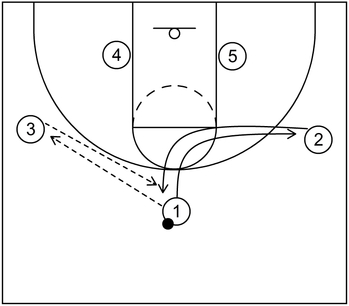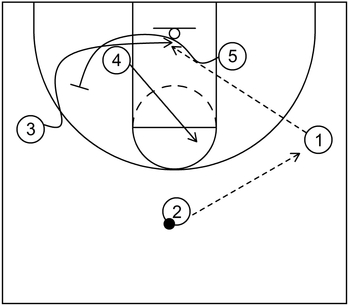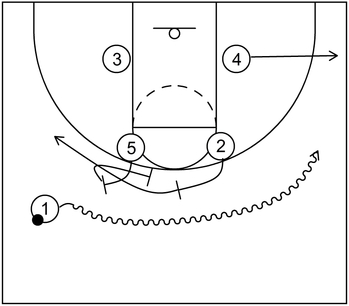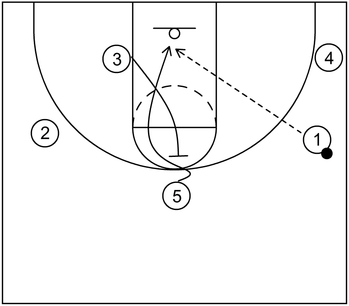General information about the alley-oop
Basic definition
The alley-oop is a term typically used to describe offensive action that happens when a player in possession of the basketball throws it toward the rim, particularly with a high arc, for a teammate that jumps off the floor, catches the ball while it is still in the air, and finishes with a layup or dunk.
Simply put, an alley-oop generally means one offensive player throws the ball in the air and another offensive player catches it to score via a layup or dunk.
Alley-oop variation
There is also a variation of the standard alley-oop, informally known as the off the backboard alley-oop, in which an offensive player in possession of the ball throws it at the backboard while another offensive player jumps off the floor, catches the ball in mid-air after it bounces off the backboard, and then finishes at the rim with a dunk or layup.
Moreover, there is a sub-variant of the off the backboard alley-oop, sometimes referred to as a self alley-oop, in which an offensive player in possession of the ball throws it at the backboard, jumps off the floor, catches the ball in mid-air after it bounces off the backboard, and then finishes at the rim, usually with a dunk.
However, it should also be noted that these two variations are commonly executed by elite athletes, particularly at the professional level, and even more specifically, in the NBA.
Related: Best Off The Backboard Alley-Oops – YouTube
Lob pass basic knowledge
It should also be noted that when an offensive player throws the ball with a high arc in the air, that type of basketball pass is commonly known as a lob pass.
Furthermore, the lob pass could be used as a post entry counter against a defensive front or simply as a key component within alley-oop action.
Brief history of alley-oop
Word origin
Historically, the English term alley-oop is derived from the French term Allez Hop!, which was seemingly a shout used by French acrobats as a system of communication prior to the execution of an acrobatic leap.
Related: The Historical Origins Of The Term ‘Alley-Oop’ – Business Insider
Additionally, the term Allez Hop could be translated into English as a word such as “Go!” or phrases such as “Off you go!” or “Let’s go!”.
Related: English translation of allez hop! – Collins French-English Dictionary
Related: Alley-oop – Etymology – Wiktionary
Relation to basketball
In terms of basketball history, the alley-oop was popularized by David Thompson during his time as a star player for North Carolina State University from the 1972 season through the 1975 season.
At that time, particularly from 1967 to 1976, dunking was illegal in college basketball.
Related: The history of the slam dunk: from outlawed move to beloved highlight – The Guardian
Therefore, David Thompson, who was known for his great vertical leap, would jump off the ground, catch a lob pass while in mid-air that was thrown by one of his teammates, and score via a layup off the backboard or by simply dropping the ball into the basket ring.
Related: The origin story of the alley-oop – ESPN
General reasons why the alley-oop is potentially effective
Create high percentage scoring opportunities
The alley-oop naturally creates high percentage scoring opportunities because the primary action always occurs near the basket and/or above the rim.
In other words, when a passer throws the initial lob pass towards the basket, the recipient of that pass would catch the ball mid-air near the basket and/or above the rim.
As a result, the quality of the shot is innately superb. That is to say, there is a very high likelihood that the recipient would score via a layup or a dunk after receiving the lob pass in mid-air.
As a side note, the player that throws the lob pass would receive an assist and the player that catches that pass to finish at the rim would receive two points, which would also be added to the team’s overall point total. Therefore, the passer, the catcher, and the entire team could benefit from the alley-oop action.
Brings excitement and generally produces greater chemistry
The alley-oop can bring excitement and possible inspiration for respective team members.
Essentially, after the completion of an alley-oop, the two offensive players that took part in the action as well as any additional teammates that are on the court or even on the bench would usually be inspired to play the game with higher confidence and courage.
Put another way, a successful alley-oop generally produces greater team chemistry as a whole and this, in turn, could lead to better basketball offense in terms of skills and overall execution as well as greater basketball defense in terms of fundamentals and tactics.
Also, as an added bonus, the alley-oop could increase engagement for spectators and fans.
Basically, when spectators see an alley-oop, this typically piques their interest and encourages them to continue watching the game.
Furthermore, when certain fans see the alley-oop performed by their favorite team, this usually motivates them to cheer and support that same team in a continuous manner.
Potential drawback of the alley-oop
A potential drawback of the alley-oop is that it could lead to turnovers, particularly if the passer’s timing is too early or too late or the passer’s throw is too high.
For example, if the passer throws the ball too early, then the receiver will not be able to jump off the ground in time to catch the ball with enough precision.
Furthermore, if the passer throws the ball too late, especially after the receiver already jumped expecting to catch the ball in mid-air, then that would almost certainly lead to a turnover.
Additionally, if the passer throws the ball too high, then the receiver would not be able to catch it because the ball would be beyond their vertical leap as well as their arm length. This, in turn, would more than likely cause the ball to sail out of bounds, which would result in a turnover.
Examples of basketball plays that incorporate the alley-oop
This section contains basketball plays that could incorporate the alley-oop within the offense, possibly leading to high percentage scoring opportunities at the rim.
Furthermore, each of the offensive players on the diagrams below are generally represented by the standard basketball positions, unless otherwise noted.
In essence, 1 is the point guard; 2 is the shooting guard; 3 is the small forward; 4 is the power forward; 5 is the center.
3 out 2 in
This is an example of a basketball play that incorporates the alley-oop action initiated from a 3 out 2 in alignment.
It also could be executed against either man to man defense or against certain zone defenses such as the 2-3 zone.
Part 1: Shallow cut

To start, 3 receives the ball from 1 and following that, 1 and 2 interchange spots on the court with shallow cuts.
Therefore, 1 cuts to the right side wing from the top while 2 cuts to the top from the right side wing. After that, 2 receives the ball from 3.
Related: Duke Basketball : Alley-oop Basketball Play – YouTube
Part 2: Back screen

Next, 1 receives the ball from 2 and as that happens, 4 flashes up to the high post as if to potentially receive the ball from 1.
However, that is simply decoy action to occupy the defense momentarily. Following that, 3 cuts to the basket via a back screen set by 5.
If the back screen is successful, then 3 could receive the ball via the lob pass thrown by 1 and then complete the alley-oop with a layup or dunk at the rim.
Box
This is an example of a basketball play that incorporates the alley-oop action initiated from a variant of the box alignment, particularly against man to man defense.
Part 1: Double ball screen

To begin the action, 1 starts near the left side and dribbles toward the right side wing via the double ball screen set by 2 and 5.
Next, 2 cuts to the left side wing by way of a flare screen set by 5, which also accomplishes screen the screener action.
Furthermore, as that happens, 4 pops out to the right side corner to occupy the defense for the time being.
Part 2: Back screen

Next, after setting the flare screen, 5 cuts to the basket via the back screen set by 3. This is also screen the screener action as well.
Afterwards, if 5 is open at the rim, then 5 could receive the ball via the lob pass thrown by 1 and score points by way of a layup or dunk to finish the alley-oop play.